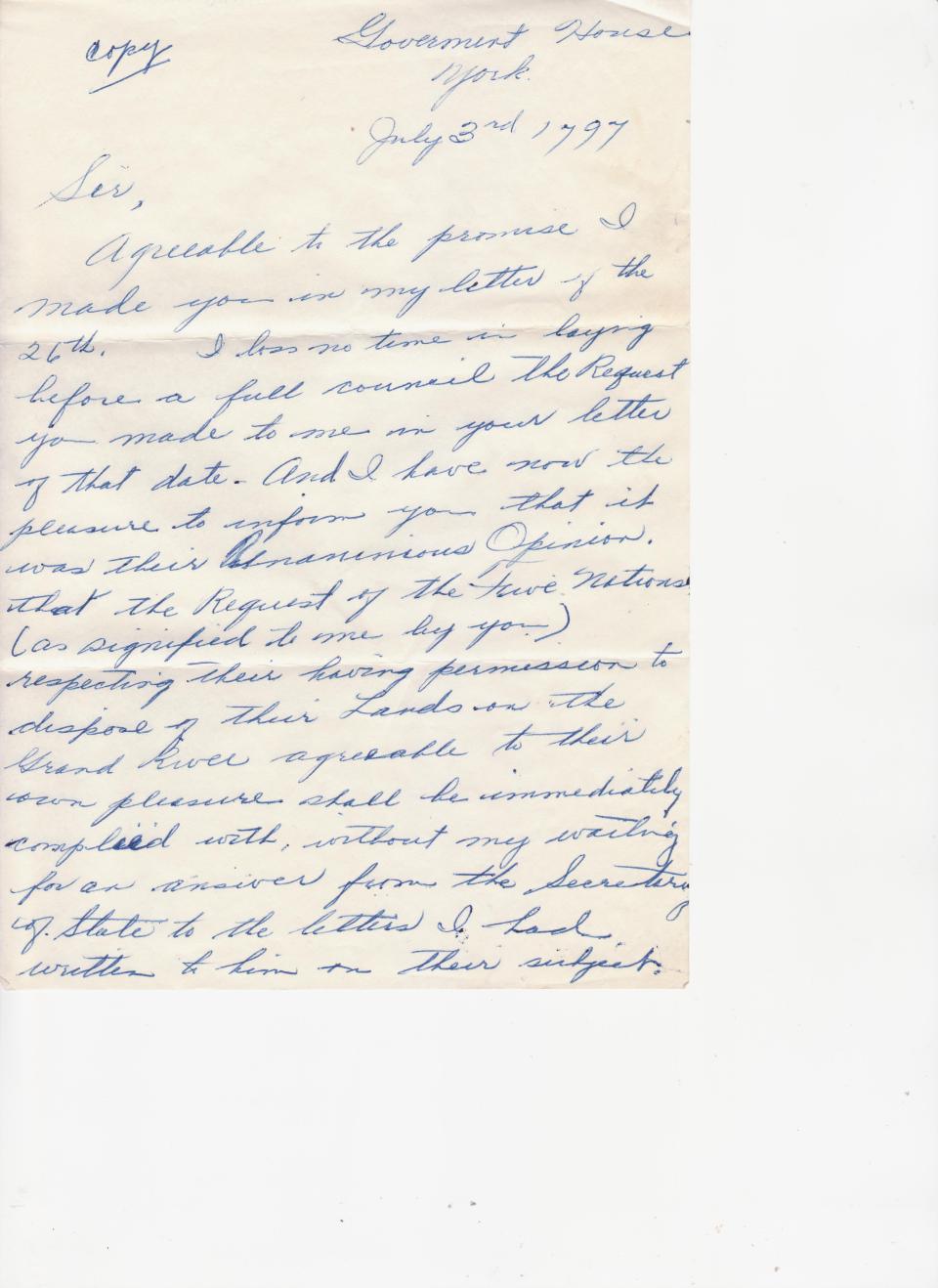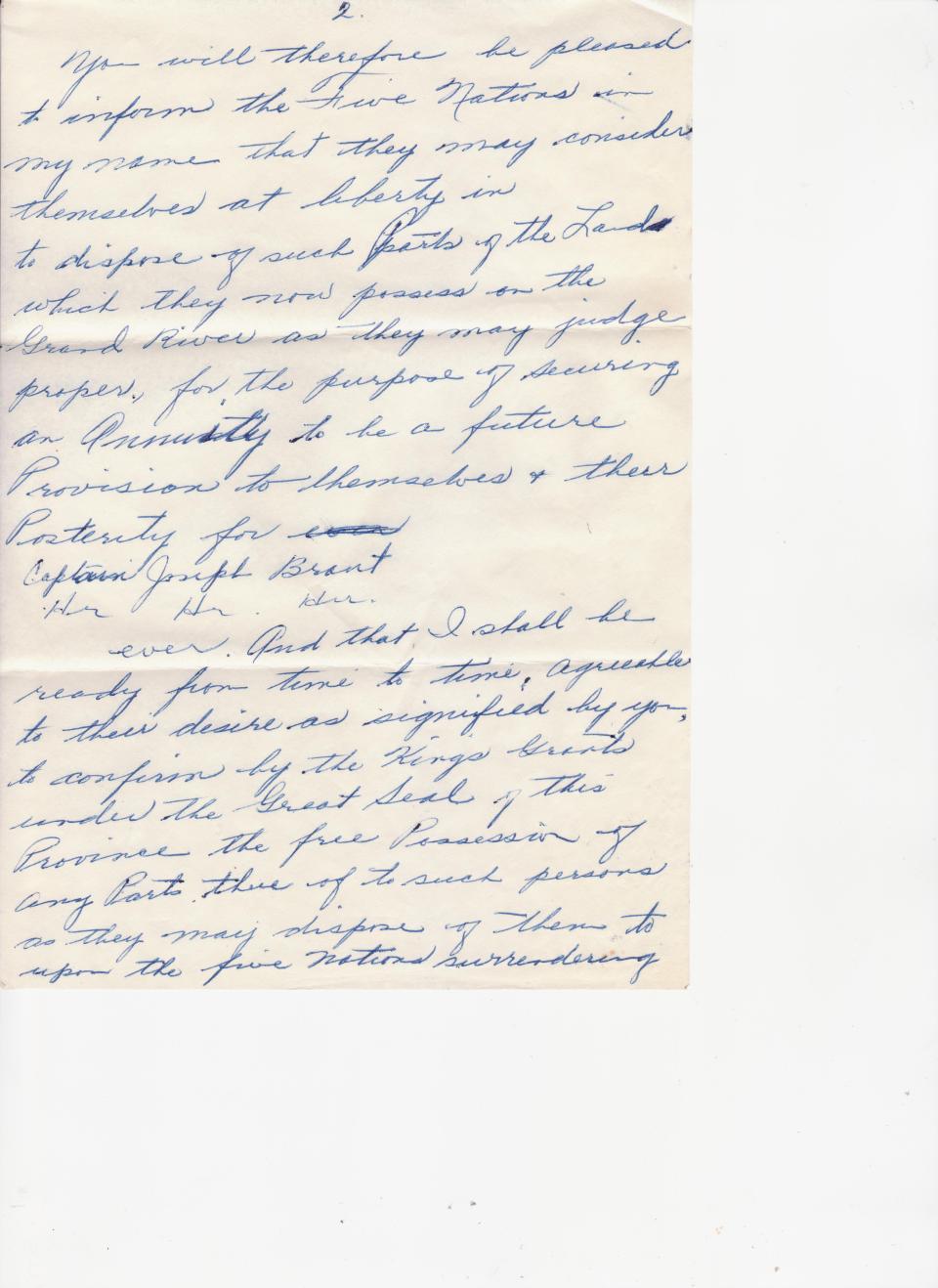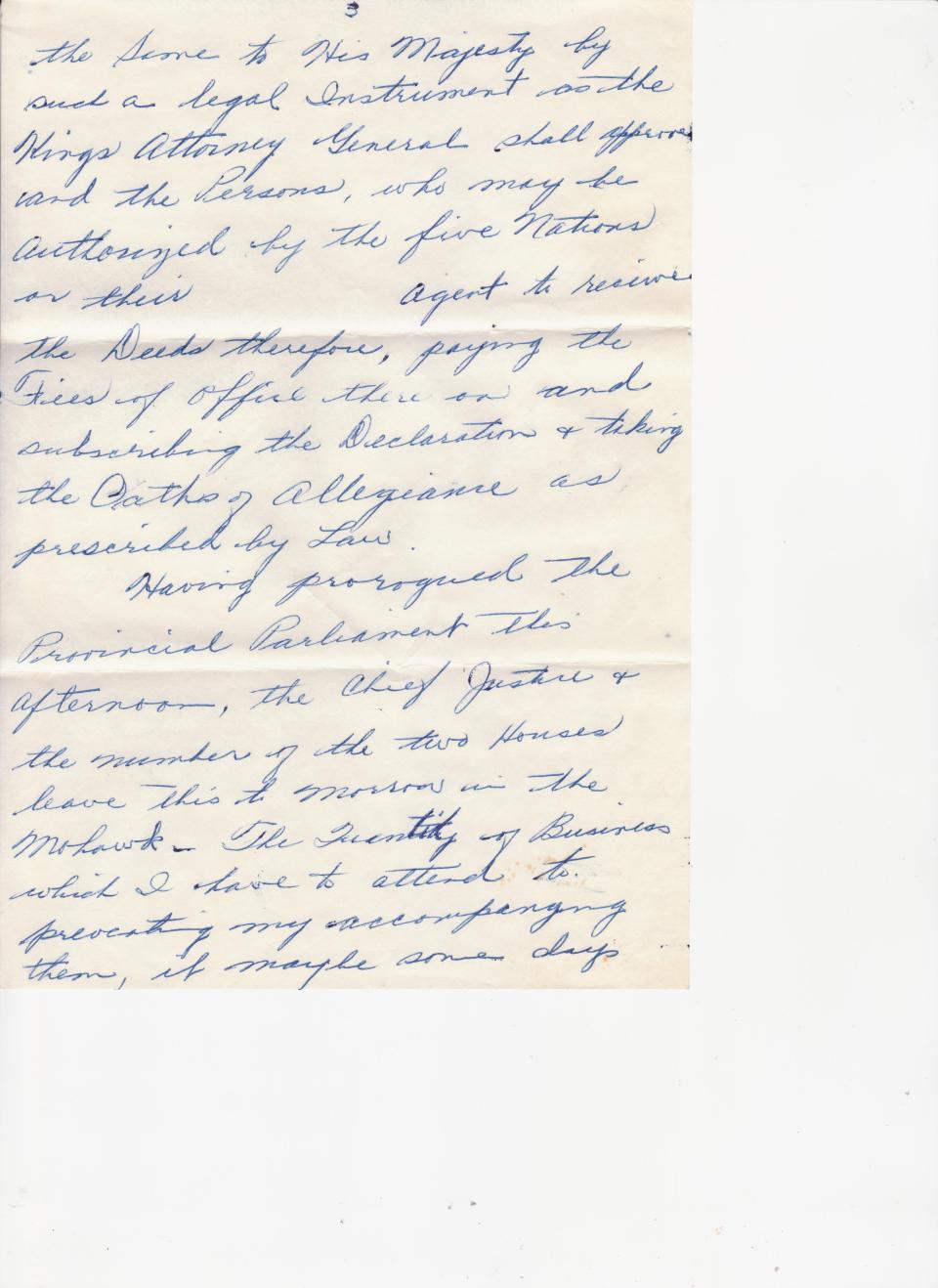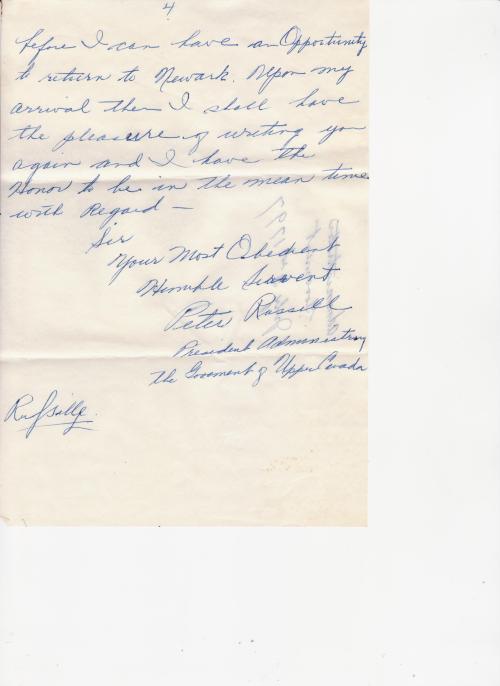On July 3rd, 1797 Peter Russell assured Ka-nyen-geh-ha-kah Principle Chief Joseph Brant unequivocally in writing that:
“Agreeable to the promise I made you in my letter of the 26th. I loss no time in laying before a full council the Request you made to me in your letter of that date. And I have now the pleasure to inform you that was their Unanimous Opinion that the Request of the Five Nations (as signified to me by you) respecting their having permission to dispose of their Lands on the Grand River agreeable to their own pleasure shall be immediately complied with, without my waiting for an answer from the Secretary of State to the letter I had written to him on their subject.
You will therefore be pleased to inform the Five Nations in my name that they may consider themselves at liberty in to dispose of such Parts of the Lands which they now possess on the Grand River as they may judge proper, for the purpose of securing an Annuity to be a future Provision to themselves & their Posterity forever.
And that I shall be ready from time to time, agreeable to their desire as signified by you, to confirm by the King’s Grants under the Great Seal of this Province the free Possession of any Parts there of to such persons as they may dispose of them to upon the five nations surrendering the Same to His Majesty by such a legal Instrument as the Kings Attorney General shall approve and the Persons, who may authorized by the five Nations or their agent to receive the Deeds therefore, paying the Fees of office there on and subscribing the Declaration & taking the Oaths of Allegiance as prescribed by law.
Having prorogued the Provincial Parliament this afternoon, the Chief Justice & the members of the two Houses leave this to morrow in the Mohawk. The Quantity of Business which I have to attend to preventing my accompanying them, it maybe some days before I can have an Opportunity to return to Newark. Upon my arrival then I shall have the pleasure of writing you again and I have the Honor to be in the mean time with Regard
Sir
your Most Obedient
Humble Servant
Peter Russell
President Administering
the Government of Upper Canada”
Peter Russell (Kitchener Papers) July 3, 1797 Letter RE: Grand River Territory
On February 26, 1787, four (4) of the “Six Nations” gave conditional leases to non-members of the Six Nations; namely, Hendrick Nellis, Robert Nellis, Warner Nellis, Adam Young, John Young, Daniel Young, Hendrick Young, John Dochsteder, Hendrick Huff, and John Huff. The lands were to be possessed by them and their descendants on condition that the said lands were never to be transferred to anyone else. These lands are known as the Nellis Tract, the Young Tract, the Huff Tract and the Dochsteder Tract and are located in what is today the Town of Haldimand.
On January 14, 1793, Lieutenant John Graves Simcoe unilaterally issues the Simcoe Patent. This patent purported to grant to the “Six Nations” 675,000 acres (223,163 hectares) of the Mohawk’s Haldimand territorial reparation 6 miles deep along either side of the Grand River from its source to its mouth at Lake Erie. This parcel usurped 275,000 acres (111,289 hectares) less than what was stipulated in the Haldimand Proclamation.
Free unconditional Crown grants were issued for these lands to third parties by twenty-one (21) letters patent dated between July 1, 1836 and November 27, 1851, and with the exception of the last such patent, were approved by Orders-in-Council of varying dates. Nevertheless, the Crown unilaterally transferred ownership of the Life Lease lands to third parties in lieu of both Mohawk permission and compensation to the Mohawks.
On February 19, 1823, Seventeen (17) “Principle Chiefs of the Six Nations” entered into an unauthorized lease with Marshal Lewis for the express purpose of constructing and operating a Grist Mill on the Grand River. On November 1, 1828, Marshal Lewis unlawfully conveyed said unlawfully leased lands to Julius Morgan for £750, who subsequently, on March 9, 1830, unlawfully conveyed same, excepting the Grist Mill and Lot containing ½ an acre, to Nathan Gage for $1,250.00. On February 25, 1840, fraudulent Letters Patent was issued to Nathan Gage for Park Lots 1, 2, 3, 4, 5, 6, 7 and westerly 4/5 of number 25 and numbers 26, 27, 28, 29 in Brantford. Also on this date, a Letters Patent was issued to Nathan Gage for Park Lots 30, 31, 32, 33, 34, 35 and 36.
On April 19th, 1830, the “Six Nations” again usurped, by ceding to the Crown, without color of right, 807 acres for an unincorporated private Town Plot at Brant’s Ford to be divided into lots and sold for “Six Nations’” benefit. Three trustees were to take charge of “Six Nations’” monies. It is said that on this date, twenty-nine (29) “Sachems and Chiefs of Six Nations” including a party listed as “Teacup” purportedly surrendered (Surrender No. 30) to the King for sale an estimated 807 acres for a Town Plot known henceforth as Brantford. On December 1st, 1831, Peter Robinson, Commissioner of Crown Lands, issued a public notice advising of the rules established by the Government for regulating the disposal of public lands.
Lands were to be surveyed, valued, sold at public auctions at prices per acre to be recommended by the Commissioner of Crown Lands. The notice also regulated the terms of payment of purchase money. John Macaulay, Surveyor General, subdivided the Town Plot of Brantford in order that lots be sold on June 29th, 1837. On September 15th, 1838 “Six Nations” reported that Sir John Colborne had advised them to surrender to the Government the lands around the Brantford Bridge and he would then compel the squatters to leave their lands. A purported ‘surrender’ was taken for that purpose which also fails to bear neither Ohrerekowa’s endorsement, nor indeed that of any recognized Ka-nyen-geh-ha-ka Principle Chief of the 5 Nations.
On February 24th, 1846, William Walker, Deputy Provincial Surveyor, received instructions from the Surveyor General for the Indian Department, to survey the remaining Town Lots of the Town of Brantford. Fraudulent Letters Patent No. 708 was issued the Municipal Council of the Town of Brantford containing 19 2/10 acres on November 5th, 1851. These lands were in the original Town of Brantford. The patent stipulated an amount of £8 which was only for the patent fee.
From 1830 to 1842, specific valuations and sale conditions were issued for Purported Surrender No. 30. Over the years, to-date, numerous other allegations of outright theft and fraud must now be examined and accounted for. For example, descriptive plans were not signed, witnessed and attached to purported ‘Surrender’ No. 30, and others, in accordance with 1812 Governor’s Instructions for the “Alienation of Indian lands”.
Further, as stated above, there has not been a single lawful conveyance of Ka-nyen-geh-ha-ka Grand River lands from the 5 Nations to any party since 1812 bearing the endorsement of Ka-nyen-geh-ha-ka Principle Chiefs’ Titles or their appointed representatives. Despite this, unauthorized actions on the part of “Six Nations” and other parties have caused Grand River lands to be usurped and disposed of under their appraised value. Some lands were never appraised and disposed of nevertheless. Other lands were obtained by individuals as ‘free grants’ and no payments whatsoever were made. Yet other lands were taken for ‘public purposes’ in lieu of authorization and any payment whatsoever. In some cases our records indicated that certain lands were obtained by way of schemes whereby only payment to the government of a patent or administration fee, etc. was required in order to obtain title to our Grand River Lands now situated within the City of Brantford.
To be clear, neither the purported surrender in respect of the Brantford Town Plot on April 19th, 1830, nor indeed the January 28th, 1842 purported general surrender in respect of other Ka-nyen-geh-ha-ka Grand River territory conformed to the Governor’s Instructions of May 1st 1812. Further, said purported “surrenders” bear neither Ohrerekowa’s endorsement, nor indeed the endorsement of any recognized Ka-nyen-geh-ha-kah Principle Chief of the Five Nations.
The Report on the Affairs of the Indian in Canada, 1844, part ii, 142-56 states:
“If the property of these Indians had been properly managed, they would at the present time have been an opulent people. Of the extensive Tracts which they have surrendered, a large portion has been sold for their benefit, and large quantities of excellent timber have been either sold or pilfered from their lands. There is at present a sum of £25,733 arising from this source, invested in the British funds – a further sum of £38,000 has been invested upon the Authority of Sir John Colborne in the Grand River Navigation Company, in which they hold three fourths of the Stock. This investment which was made by the Lieutenant Governor, in the expectation that it would not only yield an early profit, but greatly enhance the value of the remainder of the Indian Lands, has proved very unfortunate. It has absorbed all their funds, for the last Seven Years, leaving no surplus for distribution in money or provisions, as formally…” See: “The Past and Present Condition of the Six Nations”, 1842 [P.R.O., C.O. 42, v. 515, Report on the Affairs of the Indians in Canada, 1844, part ii, 142-56]
THE GRAND RIVER NAVIGATION COMPANY & THE CITY OF BRANTFORD
Brantford was incorporated as a town in 1847. On November 6th, 1848, The Grand River Navigation Company officially opened the canal and commercial navigation of the Grand River for a distance of fifty seven miles from Brantford to Dunnville was made possible. My people contend that this change contributed monumentally to the growth of Brantford’s corporate expansion and industrial wealth. We contend further that the wholesale theft of our natural resources including timber occurred between the period of 1784, through the 18th and 19th centuries by which time Brantford would become not only the third largest exporter, but also the third largest manufacturing centre for exported goods in all of Canada, after only Toronto and Montreal. Until the 1980s Brantford capitalists prospered and battled for our resources and land. This gave rise to a booming industrial city, boasting the highest paid factory wages in Ontario, including the auto industry – but by the end of 1988 Brantford began to lose its most significant industries, and unemployment in the city sky-rocketed to 24%.
The Town of Brantford foreclosed on the Grand River Navigation Company in 1861 and the upper canal system was sold to Alfred Watts in 1875 for $1. He, in turn, set up a small dynamo at the locks on Locks Road and, by 1885, I am told that certain businesses and streets were lit with Brantford’s own hydro electric power generated by the natural force of the Grand River. This power plant was the first in Ontario. I understand that the company passed through several stages until May 15th, 1911, when hydro from DeCew Falls began servicing Brantford.
Indeed the (November 1901) Industrial Recorder of Canada published the following statement:
“The opening of the canal was undoubtedly one of the chief factors in the early prosperity of Brantford, as it was for several years the only available avenue through which the produce of the district could reach the outside market, besides contributing to the establishment of mills and factories along the river.” Pg. 4




